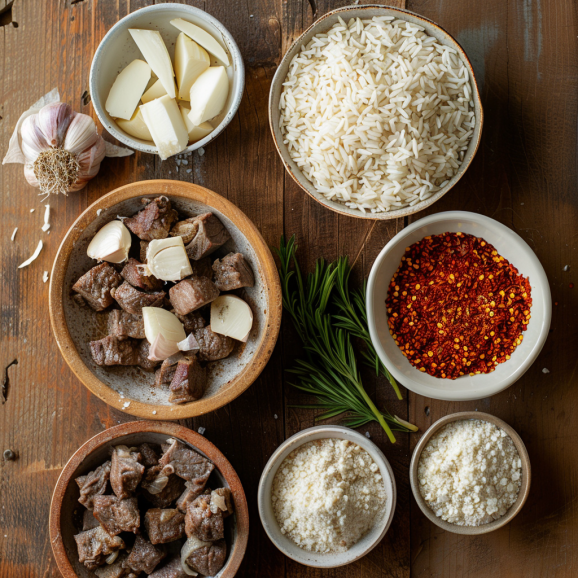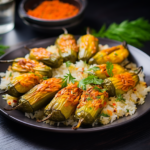
Cretan cuisine is renowned for its simplicity, rich flavors, and use of fresh, local ingredients. Among the many traditional dishes, Cretan Gamopilafo stands out as a symbol of celebration and hospitality. This sumptuous rice dish, often served at weddings and special occasions, reflects the essence of Cretan culture and culinary tradition. In this blog post, we will explore the history, ingredients, and preparation of Cretan Gamopilafo, along with an FAQ section and a detailed recipe to help you recreate this dish at home.
The Origins and Significance of Gamopilafo
Gamopilafo, literally translating to “wedding pilaf,” is a dish deeply rooted in the traditions of Crete. Historically, it was prepared for wedding feasts, symbolizing prosperity and the joy of the union. The dish is a luxurious combination of rice, lamb, goat, or chicken, cooked in a rich, flavorful broth. The key to its distinctive taste lies in the simplicity of its ingredients and the meticulous cooking process that extracts maximum flavor.
The Tradition of Cretan Weddings
In Cretan culture, weddings are grand celebrations that bring together families and communities. Food plays a central role in these festivities, with dishes like Wedding Rice Pilaf taking center stage. The preparation of Gamopilafo is often a communal activity, involving several family members and friends, which adds to the dish’s significance and the joy of the occasion.
Key Ingredients of Wedding Rice Pilaf
- Meat: Traditionally, lamb or goat is used, but chicken is also a popular choice. The meat is simmered to create a rich, flavorful broth.
- Rice: Medium-grain rice is preferred for its ability to absorb flavors while maintaining a slightly firm texture.
- Broth: The broth is the soul of Gamopilafo, made by simmering the meat with aromatic herbs and spices.
- Lemon: Fresh lemon juice is added to enhance the dish’s flavor, adding a tangy brightness.
- Butter: A generous amount of butter is used to give the rice a creamy, luscious texture.
Health Benefits of Gamopilafo
While Gamopilafo is a hearty dish, it also offers several health benefits:
- Protein: The meat provides a good source of protein, essential for muscle repair and growth.
- Vitamins and Minerals: The broth contains nutrients from the meat and bones, including vitamins, minerals, and collagen.
- Balanced Nutrition: Combining protein and carbohydrates, Gamopilafo offers a balanced meal that can be part of a healthy diet.
Recipe: How to Make Cretan Wedding Rice Pilaf
Ingredients
- 1 kg lamb or goat (or chicken)
- 2 cups medium-grain rice
- 4 cups meat broth
- 2 lemons (juice)
- 100g butter
- Salt and pepper to taste
- Fresh parsley for garnish
Instructions
- Prepare the Meat and Broth:
- In a large pot, place the meat and cover it with water. Add a pinch of salt.
- Bring to a boil, then reduce the heat and simmer for about 1.5 to 2 hours until the meat is tender.
- Skim off any foam that forms on the surface.
- Remove the meat from the pot and set aside. Strain the broth and keep it warm.
- Cook the Rice:
- In a large pan, melt the butter over medium heat.
- Add the rice and stir to coat the grains with butter.
- Gradually add the hot broth, one ladle at a time, stirring constantly.
- Continue adding the broth until the rice is cooked and has absorbed most of the liquid. The texture should be creamy, not dry.
- Add the lemon juice and stir well.
- Serve:
- Transfer the rice to a serving platter.
- Place the meat on top of the rice.
- Garnish with fresh parsley and a drizzle of lemon juice.
- Serve hot.
FAQs About Cretan Gamopilafo
Q1: Can I use other types of meat for Gamopilafo?
A1: Yes, while lamb and goat are traditional, chicken and even beef can be used.
Q2: Is there a vegetarian version of Gamopilafo?
A2: Traditionally, Gamopilafo is made with meat, but you can create a vegetarian version using vegetable broth and adding mushrooms for a meaty texture.
Q3: What type of rice is best for Gamopilafo?
A3: Medium-grain rice is preferred for its ability to absorb flavors and maintain a slightly firm texture.
Q4: How do I store leftover Gamopilafo?
A4: Store leftovers in an airtight container in the refrigerator for up to 3 days. Reheat in a pan with a bit of broth to restore the creamy texture.
Q5: Can I freeze Gamopilafo?
A5: Yes, you can freeze Gamopilafo. Allow it to cool completely before transferring to a freezer-safe container. Freeze for up to 3 months. Thaw overnight in the refrigerator before reheating.
The Cultural Context of Wedding Rice Pilaf
Cretan cuisine reflects the island’s rich history and diverse influences. The use of simple, high-quality ingredients is a hallmark of Cretan cooking, and Gamopilafo is no exception. The dish embodies the island’s agricultural heritage, where fresh meat, dairy, and produce are staples of the diet.
Celebratory Feasts
In Crete, food is a central part of any celebration. Weddings, christenings, and other significant events feature elaborate meals that showcase traditional dishes like Wedding Rice Pilaf. These feasts are not just about the food but also about bringing people together, celebrating community and family.
The Role of Women in Cretan Cuisine
Traditionally, women have been the custodians of Cretan culinary heritage. Recipes are passed down from generation to generation, often without written instructions. The preparation of Gamopilafo, especially for large gatherings, is a collective effort, involving multiple generations and reinforcing family bonds.
Modern Adaptations of Wedding Rice Pilaf
While the traditional recipe for Gamopilafo remains popular, modern adaptations have emerged, catering to diverse tastes and dietary preferences. Some variations include:
- Vegetarian Gamopilafo: Using vegetable broth and adding mushrooms, bell peppers, and zucchini.
- Seafood Gamopilafo: Incorporating seafood like shrimp or mussels for a coastal twist.
- Herb-Infused Gamopilafo: Adding fresh herbs like dill, mint, and basil to enhance the flavor.
Tips for Perfecting Gamopilafo
- Use Fresh Ingredients: The quality of the ingredients significantly impacts the flavor of Wedding Rice Pilaf. Use fresh, locally-sourced meat and produce whenever possible.
- Simmer Slowly: Take your time to simmer the meat and extract maximum flavor for the broth.
- Balance the Flavors: The right balance of lemon, butter, and seasoning is crucial for the perfect Gamopilafo.
- Serve Immediately: Gamopilafo is best served hot, straight from the pan, to retain its creamy texture.
Helpful Links to Cretan Cuisine
- Xinohondros Traditional Cretan Soup – Discover the unique flavors of this fermented wheat and goat’s milk soup.
- Cretan Cuisine: Vibrant Flavors – An overview of the vibrant and diverse Cretan cuisine.
- Sfakianes Pites: Pies from Sfakia – A deep dive into another traditional dish from Sfakia.
- Greek Kalitsounia: The Crete Specialty – Explore the flavors of these savory Cretan pastries.
- Cretan Mushrooms in a Red Wine Sauce – A delicious mushroom recipe with a Cretan twist.
- Dakos Salad Recipe from Crete – A refreshing Cretan salad perfect for any meal.
- Cretan Honey: The Greek Island of Crete – Learn about the unique honey varieties from Crete.
- Traditional Greek Cooking Techniques – Explore the methods that make Greek cooking special.
- Exploring the Richness of Greek Desserts – A journey through the sweet side of Greek cuisine.
- Greek Food Festivals and Traditions – Celebrate Greek culture through its food festivals.
You can find authentic Cretan recipes on websites dedicated to Greek and Mediterranean cuisine, such as Chef on a Bike and Digital Heroes Caffe. These sources provide a wealth of traditional recipes and cooking tips.


















